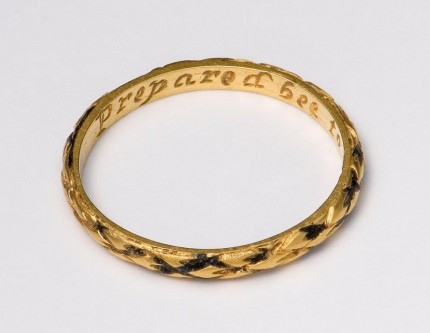
A mourning ring discovered by a metal detectorist in a field in Pennard, Swansea, Wales, was officially declared treasure by a Swansea Coroners Court on Monday. According to the terms of the 1996 Treasure Act, any artifact that is at least 10% precious metal by weight and at least 300 years old is treasure and thus property of the Crown. The ring is 81% gold and 9% silver, and although experts were unable to give it a precise date, the decoration strongly suggests it’s from the 17th century. The outside of the ring in engraved with a cross-hatch or trellis pattern inlaid with black enamel. The inside is inscribed “prepared bee to follow me,” a common expression in 17th century mourning jewelry. The double-e spelling of “bee” is characteristic of the second half of the 1600s.
The finder is 71-year-old Ron Pitman who unearthed the ring in October of 2010 in a field used to grow corn. All the farming activity on the field left the ring just five inches below the surface. Now that the piece has been declared treasure, Pitman and the landowners (the Layton family) will split a finder’s fee in the amount of its market value as determined by a committee of experts at the National Museum in Cardiff. A local museum will be given the first opportunity to pay the fee and keep the ring. The Swansea Museum has already expressed interest.
The late 17th century saw a great boom in mourning jewelry thanks to the Great Plague of London (1665-6). Indeed, one of the rings experts used as a comparison in their assessment because of its nearly identical inscription — “Prepared bee to followe me” — dates to 1667. It would see a whole new surge in popularity 1861, inspired by Queen Victoria’s perpetual mourning for her husband Prince Albert. In the 19th century mourning jewelry would expand from the slender blackened rings of the 1600s to a wide variety of pieces — brooches, lockets, pendants, miniatures, rings with glass or gemstone windows in which a lock of hair of the deceased could be kept and much more.
If you’re at all interested in the history of mourning jewelry and art, run, don’t walk, to Hayden Peters’ exceptional blog The Art of Mourning. He’s a jewelry historian with an extensive collection of mourning pieces that he writes about, using the jewels and art as a prism through which to explore personal and societal approaches to loss and grief. His blog is a consistently fascinating, touching and beautiful read. Phenomenal pictures, too.